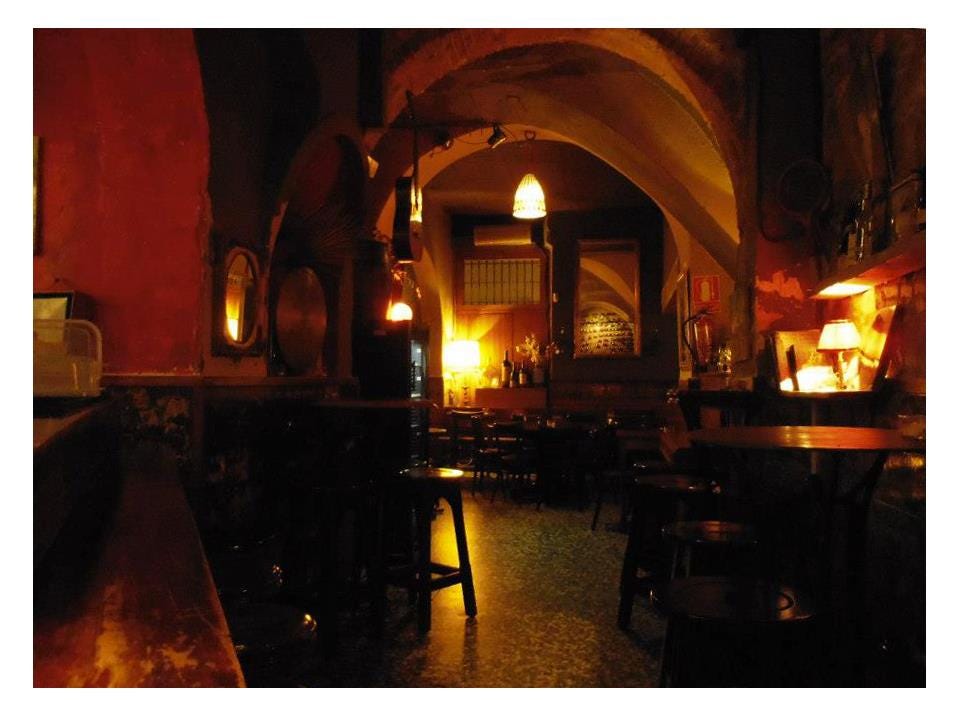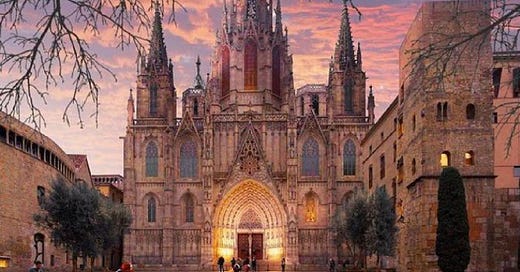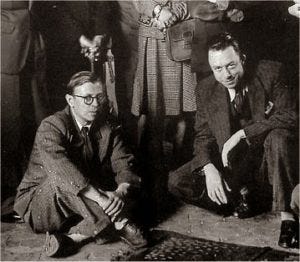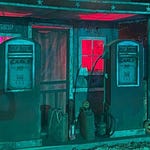Welcome to “In the Dark by Babs Babylon” — a podcast and Substack page that explores nocturnal matters.

I am, by nature, a rational person — somebody who pays bills on time and believes in gravity, four walls, and a round Earth.
However, every so often, strange things happen that I find difficult to rationally explain.
Take, for instance, The Case of the Floating Shoe.
It was May 2011. I was back in Barcelona for the first time in 6 years.
It, of course, looked familiar, since every single night of the previous 6 years, I’d been wandering down the winding stone streets of the city’s haunting Gothic Quarter in my mind.
The eerieness of Barcelona’s Gothic Quarter stems from more than the fact that its streets snake past medieval squares where heretics were once burned at the stake, past buildings where the plague had set in, past buildings where Jews had been driven out because they hadn’t succumbed to the plague, past now-placid squares where priests and nuns had been gunned down during the Spanish Civil War.
Only increasing the general vibeyness of the place is what lies below. Some 12 feet under these stone streets spreads an ancient Roman town, complete with laundries, wineries, homes and Roman baths. And dotting the subterranean city are 2000-year-old wells that still fill with clear water. Some say the ancient Roman wells are portals to another world.
So maybe that’s why I’m drawn to the place and why strange things happen there and why if I’m not in Barcelona actually wandering its streets that, wherever I am, I’m wandering them in my mind.

.Of course, when I returned in 2011, I headed straight for the Gothic Quarter to meet my friend Roxanne at a bar named Andú, hidden on a narrow street that few wandered down. Walking in, you were swallowed up in a meandering candle-lit cave with stone arches and red velvet curtains, with shadow-flickery walls like something out of a film noir flick. Felt like a Gothic womb.

Andú has a Roman well in the basement, and if you ask me — and a bunch of other people, including the last owner — the place was thick with phantasms.
And weirdos. The regulars were, um, a colorful bunch — one came in every night with a white cockatoo perched on his shoulder. Another, a seriously creepy guy who performed on the Rambla, came in carting his prop — a coffin that he laid in for hours as part of his performance art act.
But even among the normal-ish sorts, who weren’t prone to excessive drinking, many experienced blackouts at Andú, exhibiting bizarre behaviors that brought them back the next day trying to put together the pieces of the previous night.
Strange smells wafted through — weird even for Barcelona — and an assortment of old instruments filled the place. Many who passed through Andú commented that the rusty tuba hanging on the wall had a ghost attached to it, probably that of its previous owner, still blowing away in some other dimension.
One night, six years before, with a glass of wine at the corner table, I started writing an essay at Andú — about how philosopher Jean-Paul Sartre and writer Albert Camus had been the best of friends. I’d had a few sips of wine and had only written a few lines, when an unseen entity took control of the pen. It raced across the page writing about Sartre’s excesses and abuses, how he was surrounded by sycophants, how he chewed people up and spit them back out, and how he was a stain on the modern history of France.
The written rant quickly filled up two pages when I finally asked aloud, “Who is controlling this pen?” The pen wrote: Camus. I laughed and said, “If this is Camus, what is your birthday?” The pen wrote: 6 November, 1913.
And then it stopped writing.
I ran to the bar waving the pages, making a memorable scene yelling, “I didn’t write this. Something took control of the pen! It was writing on its own!”
That night at home I looked up the official birthdate of Albert Camus: it was November 1913, but the official date was November 7th, not the 6th as I’d written. The weird thing is that, years later, when I met Camus’ twins, Catherine and Jean, and told them about the experience, they said the family had long believed Camus’ true birthday was November 6, but it hadn’t been registered until the next day.
And his twins understood what the rant was about, as by then, so did I: While they’d been friends in the 1940s, Sartre had turned on Camus in the Fifties, effectively running him out of Paris.
But that night in 2011, when I returned to Barcelona, nothing particularly strange happened at Andú. Roxanne and I each had a glass of wine, and then left for her place, where I would be spending the night.
Roxanne’s lovely Gothic Quarter apartment is perched on the top floor of an 18th-century stone building and it has those stunning old-style mosaic floors — patterned in the shape of a star.
I’d lived there before and had two anxieties about returning to her beautiful place. Located on the fifth floor, it required walking up many, many stairs. The first floors had smooth marble steps, but the higher floors had stairs made of bricks, some of them damaged or missing, making the ascent rather precarious.
But the most disconcerting part of the upward trek was the handrail: on the upper floors, the stair rail was missing. This was because the former owner of Roxanne’s apartment had fallen from the top floor, down the shaft, crashing into the rails and breaking them off in his fatal plunge.
Roxanne bought the apartment right after that.
When I’d lived there before, I became convinced that the former owner was still living there, too — but Roxanne, whose belief system is possibly more existential than that of Jean-Paul Sartre, always laughed at my stories about hearing footsteps across the apartment at 3 AM.
That night we sat at the small wood table in the kitchen of her apartment, a corner I’d always found particularly spooky. As she opened a bottle of wine, I slipped off my new ankle boots.
“Aren’t these darling?” I said, holding them up. “I got them at an outdoor market for 5 euros!”
She nodded at the upheld boots appreciatively, placed a glass of wine before me, and promptly headed off to the bathroom.
Waiting alone at the table I got a sudden chill and looked up at the candleholder mounted high in the corner. I really felt like the former owner was up there, looking down.
Which of course was a ridiculous notion, one that I tried to lighten.
“Hey, Mr. Ghost,” I said to the candleholder where I imagined the former owner was hovering. “Long time. How’s it going?”
Honestly, I did not expect a response.
But then I looked at my shoe: The ankle boot that was levitating three feet in the air.
“Roxanne,” I yelled. “Get out here right now!”
Then the floating shoe began turning side to side, as if an unseen somebody was admiring it from assorted angles.
“ROXANNE! Hurry up! You’ve got to see this!”
The spectacle continued for at least a full minute — and then the shoe dropped to the floor.
Of course, that’s when Roxanne finally walked out, asking what the hell I was screaming about.
And, of course, she didn’t believe me: she chalked it up to the wine, while I chalked it up to her resident ghost, and the first person I told the story to the next day chalked it to a giant cockroach that had somehow gotten into my shoe.
While that might have explained the rocking side-to-side movements, I noted, it didn’t explain how the shoe could be floating three feet high. He solemnly took that into consideration. “But you must remember,” he said, “some cockroaches can fly.”











Share this post